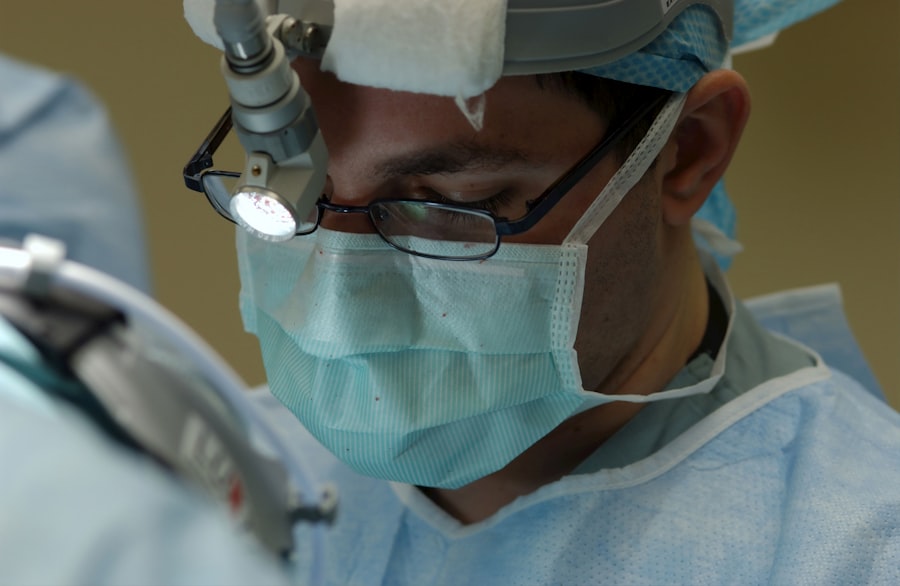A mastectomy is a surgical procedure that involves the removal of one or both breasts, typically as a treatment for breast cancer. This operation is often recommended when cancer is diagnosed or when there is a high risk of developing breast cancer due to genetic factors or family history. The decision to undergo a mastectomy can be daunting, as it not only affects physical health but also has profound emotional and psychological implications.
Understanding what a mastectomy entails can help you make informed decisions about your health and treatment options. The procedure itself can vary in scope and technique, depending on the individual case and the extent of the disease. While some women may opt for a total mastectomy, which removes the entire breast, others may choose a partial mastectomy, where only a portion of the breast tissue is excised.
Regardless of the type, the goal remains the same: to eliminate cancerous cells and reduce the risk of recurrence. As you navigate this journey, it’s essential to gather information and seek support to help you through the process.
Key Takeaways
- A mastectomy is a surgical procedure to remove breast tissue, often used to treat or prevent breast cancer.
- Types of mastectomy surgery include total mastectomy, partial mastectomy, and radical mastectomy, each with different levels of tissue removal.
- Preparing for mastectomy surgery involves discussing options with a healthcare provider, arranging for support, and understanding the recovery process.
- During mastectomy surgery, patients can expect to be under general anesthesia and have the affected breast tissue removed.
- The recovery process after mastectomy surgery may involve pain management, physical therapy, and emotional support to address the physical and emotional effects of the procedure.
Types of Mastectomy Surgery
There are several types of mastectomy surgeries, each tailored to meet specific medical needs and personal preferences.
A total mastectomy involves the complete removal of one breast, including the nipple and areola.
This approach is often recommended for patients with invasive breast cancer or those who have a high risk of developing cancer in the other breast. Modified radical mastectomy, on the other hand, removes not only the breast tissue but also some of the lymph nodes under the arm. This type of surgery is typically performed when cancer has spread to these lymph nodes, allowing for a more comprehensive treatment approach.
Skin-sparing mastectomy is another option that preserves most of the breast skin while removing the underlying tissue and nipple. This technique is often chosen by women who plan to undergo immediate breast reconstruction, as it can lead to better aesthetic outcomes.
Preparing for Mastectomy Surgery

Preparing for a mastectomy involves several steps that can help ease your mind and ensure a smoother surgical experience. First and foremost, you should have an in-depth discussion with your healthcare team about the procedure, its risks, and what to expect. This conversation will help you understand the rationale behind the surgery and allow you to voice any concerns or questions you may have.
It’s crucial to feel comfortable with your medical team, as they will guide you through this challenging time. In addition to discussing the surgery itself, you should also prepare for your recovery period. This may involve arranging for assistance at home, especially during the initial days following surgery when mobility may be limited.
Mental preparation is equally important; consider engaging in relaxation techniques or seeking counseling to help manage any anxiety or fear surrounding the surgery.
What to Expect During Mastectomy Surgery
| Aspect | Information |
|---|---|
| Procedure | Mastectomy surgery involves the removal of breast tissue, and in some cases, lymph nodes. |
| Anesthesia | General anesthesia is typically used for mastectomy surgery. |
| Duration | The surgery can take several hours to complete, depending on the extent of the procedure. |
| Hospital Stay | Patient may need to stay in the hospital for a few days after the surgery. |
| Recovery | Recovery time can vary, but it may take several weeks to months to fully recover from mastectomy surgery. |
On the day of your mastectomy, you will arrive at the hospital or surgical center where your procedure will take place. After checking in, you will be taken to a pre-operative area where medical staff will prepare you for surgery. This may include changing into a hospital gown, receiving an intravenous (IV) line for medication, and meeting with your surgical team to review the procedure one last time.
It’s normal to feel a mix of emotions—nervousness, anticipation, or even relief—as you approach this significant milestone in your treatment journey. Once in the operating room, you will be given anesthesia to ensure you remain comfortable and pain-free throughout the procedure. The length of surgery can vary depending on the type of mastectomy being performed but typically lasts between one to three hours.
During this time, your surgeon will carefully remove the necessary tissue while taking precautions to minimize damage to surrounding areas. After the surgery is complete, you will be moved to a recovery area where medical staff will monitor your vital signs as you wake up from anesthesia.
Recovery Process After Mastectomy Surgery
The recovery process following a mastectomy can vary significantly from person to person, but there are some common experiences that many patients share. Initially, you may feel groggy or disoriented as the anesthesia wears off. Pain management will be a priority during this time; your healthcare team will provide medications to help alleviate discomfort and promote healing.
It’s essential to communicate openly about your pain levels so that adjustments can be made as needed. As you begin to regain your strength, you will likely be encouraged to start moving around gently. This can help prevent complications such as blood clots and promote circulation.
However, it’s important to listen to your body and not push yourself too hard too soon. You may also need to attend follow-up appointments for wound care and monitoring your recovery progress. Remember that healing takes time; be patient with yourself as you navigate this new chapter in your life.
Physical and Emotional Effects of Mastectomy Surgery

Undergoing a mastectomy can lead to various physical and emotional effects that may take time to process fully. Physically, you may experience changes in sensation in the chest area, swelling, or discomfort as your body adjusts post-surgery. Some women report feelings of tightness or heaviness in their chest, while others may experience numbness or tingling due to nerve involvement during surgery.
It’s crucial to follow your healthcare provider’s recommendations for physical therapy or exercises designed to improve mobility and strength in the affected area. Emotionally, a mastectomy can bring about feelings of loss or grief related to changes in body image and femininity. You might find yourself grappling with questions about self-identity and how these changes affect your sense of self-worth.
It’s perfectly normal to experience a range of emotions during this time—sadness, anger, anxiety, or even relief after making a decision about treatment. Seeking support from friends, family, or professional counselors can be invaluable as you navigate these complex feelings.
Support and Resources for Mastectomy Patients
Finding support during your journey can make a significant difference in how you cope with the challenges of undergoing a mastectomy. Many organizations offer resources specifically tailored for individuals facing breast cancer and mastectomy procedures. Support groups provide an opportunity for patients to connect with others who have shared similar experiences, allowing for open discussions about fears, triumphs, and coping strategies.
In addition to peer support groups, consider reaching out to healthcare professionals who specialize in oncology care. They can provide valuable information about post-operative care, rehabilitation options, and emotional support services available in your community. Online resources are also abundant; websites dedicated to breast cancer awareness often feature forums where patients can share their stories and advice with one another.
Long-Term Care and Follow-Up After Mastectomy
Long-term care following a mastectomy is essential for monitoring your health and ensuring that any potential complications are addressed promptly. Regular follow-up appointments with your healthcare provider will allow them to assess your recovery progress and check for any signs of recurrence or complications related to surgery. These visits are an opportunity for you to discuss any ongoing concerns or questions about your health.
In addition to medical follow-ups, consider incorporating lifestyle changes that promote overall well-being. This may include adopting a balanced diet rich in nutrients, engaging in regular physical activity tailored to your abilities, and prioritizing mental health through mindfulness practices or therapy sessions. Remember that healing is not just physical; nurturing your emotional health is equally important as you move forward after surgery.
Embrace this new chapter with resilience and seek out resources that empower you on your journey toward recovery and wellness.
If you are considering mastectomy surgery and want to learn more about what to expect during the recovery process, you may find this article on inlaserhairremoval.com helpful. The article provides valuable information on the recovery timeline, potential side effects, and tips for managing pain and discomfort post-surgery. It also offers insights on how to care for yourself both physically and emotionally during this challenging time.
FAQs
What is a mastectomy surgery?
A mastectomy is a surgical procedure to remove the entire breast. It is often performed as a treatment for breast cancer or as a preventive measure for individuals at high risk of developing breast cancer.
What can I expect during the recovery period after a mastectomy?
Recovery after a mastectomy can vary from person to person, but generally, patients can expect to experience some pain, swelling, and limited arm movement in the initial weeks following the surgery. It is important to follow the post-operative care instructions provided by the medical team to aid in the recovery process.
How long does it take to recover from a mastectomy surgery?
The recovery period after a mastectomy can vary, but most patients can expect to gradually resume their normal activities within 4 to 6 weeks. However, it may take several months to fully recover and regain strength and mobility in the affected area.
What are some common side effects or complications after a mastectomy?
Common side effects after a mastectomy may include pain, swelling, bruising, and numbness in the chest and arm. Some patients may also experience emotional distress or body image issues. Complications such as infection, blood clots, or lymphedema (swelling in the arm) are also possible but rare.
What are some tips for managing the recovery process after a mastectomy?
Some tips for managing the recovery process after a mastectomy include following the post-operative care instructions provided by the medical team, engaging in gentle arm exercises to improve mobility, seeking emotional support from loved ones or support groups, and discussing any concerns or questions with the healthcare provider.





